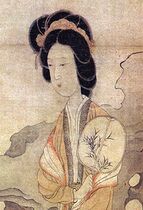Engineering:Tuanshan
Template:Infobox clothing type
| Tuanshan |
|---|
Script error: The function "transl" does not exist. (simplified Chinese: 团扇; traditional Chinese: 團扇; pinyin: tuánshàn; literally: 'circular fan'), also called Script error: The function "transl" does not exist. (literally: 'palace fan'),[1] Script error: The function "transl" does not exist. (pien mien),[2](pp203, 206) fan of reunion, are typically silk rigid hand fan which originated in China ; they are typically circular or oval in shape.[3][4](p5)[2](p206) Up to the Song dynasty, the Script error: The function "transl" does not exist. appears to have the most common types of the fans in China.[3] These types of fans were mostly used by women in the Tang dynasty.[5] Script error: The function "transl" does not exist. with Chinese paintings and with calligraphy became very popular by the Song dynasty[4](pp8, 12–16) among court circles and artists[1] and even continued to be in use even by the end of the 19th century.[2](p206) The Script error: The function "transl" does not exist. was also used as part of the traditional Chinese wedding and was part of the ceremonial wedding rite.[6] They continue to be produced and sold in present-day China and has become a common form of accessory in Script error: The function "transl" does not exist..[7]
The Script error: The function "transl" does not exist. was also introduced in other countries, such as Japan .[5] The Script error: The function "transl" does not exist. also remained mainstream in China even after the growing popularity of the folding fans which originated in Japan .[4](pp8, 12–16)
Origins
The Script error: The function "transl" does not exist. originated in China, its prototype was round silk fan which was developed in the Eastern Han dynasty which was itself developed based on the earlier Chinese fans design.[8]
Cultural significance
Fans play a significant aspect in Chinese culture and Chinese life regarding of social identities and ranks,[1] having functional usage such as cooling and facilitates air circulation and was used as a sartorial accessory and held an important ceremonial use.[3][9] Over time, the Chinese fans have evolved in a cultural artifacts which reflects and incorporate the essence of Chinese folklore culture.[1]
Wedding
Chinese brides also used a type of moon-shaped Script error: The function "transl" does not exist. in traditional Chinese wedding called Script error: The function "transl" does not exist..[6] The ceremonial rite of Script error: The function "transl" does not exist. was an important ceremony in Chinese wedding: the bride would hold it in front of her face to hide her shyness, to remain mysterious, and as a way to exorcise evil spirits.[6] After all the other wedding ceremonies were completed, such as drinking the Script error: The function "transl" does not exist. wine, and after the groom had impressed the bride (e.g. reciting poems), the bride would then proceed in revealing her face to the groom by removing the Script error: The function "transl" does not exist. from her face.[6][8] This ceremonial rite is referred as Etiquette of removing fan; the performance of such rite can be traced back to the Tang dynasty and continued in the Song dynasty.[8]
Design and construction
The Script error: The function "transl" does not exist. is composed of a handle or stick with a rigid mount like a frame and a fabric whose shape will conform to the desired shape of the Script error: The function "transl" does not exist..[3][10](pp256) Traditionally, they were made of bamboo or ivory with silk fabric, which would stretch across the rigid frame.[2](p206) It could be decorated with Chinese embroideries or Chinese paintings.[2](p206)
See also
- Hanfu accessories
- Traditional Chinese wedding dress
- Hand fan
Gallery
An hexagonal rigid fan with a Chinese painting of a cat and a calligraphy, late Qing dynasty.
Notes
References
- ↑ 1.0 1.1 1.2 1.3 "Chinese Fan, Once a Symbol of Literati and Social Status - 中国东盟传媒网". http://www.china-asean-media.com/show-114-22801-1.html.
- ↑ 2.0 2.1 2.2 2.3 2.4 Garrett, Valery (2012). Chinese Dress : From the Qing Dynasty to the Present.. New York: Tuttle Pub. ISBN 978-1-4629-0694-9. OCLC 794664023. https://www.worldcat.org/oclc/794664023.
- ↑ 3.0 3.1 3.2 3.3 "Chinese Fans | Chinese Art Gallery | China Online Museum". http://www.chinaonlinemuseum.com/painting-fans.php.
- ↑ 4.0 4.1 4.2 Qian, Gonglin (2004). Chinese fans : artistry and aesthetics (1st ed.). San Francisco: Long River Press. ISBN 1-59265-020-1. OCLC 52979000. https://www.worldcat.org/oclc/52979000.
- ↑ 5.0 5.1 "A Brief Introduction to Hanfu's Fans Culture - 2021" (in en-US). 2019-06-04. https://www.newhanfu.com/886.html.
- ↑ 6.0 6.1 6.2 6.3 "Chinese Fan — History, Tradition, and Culture | ChinaFetching" (in en). https://www.chinafetching.com/chinese-fan.
- ↑ "汉服那些事儿——汉服配饰知多少_腾讯新闻" (in zh). https://new.qq.com/rain/a/20200701A0TNB000.
- ↑ 8.0 8.1 8.2 Peng, Jing; Ruan, Tianhua (2019). "The application of fan culture in environmental design". 2019 International Conference on Management, Finance and Social Sciences Research (MFSSR 2019) (Francis Academic Press, UK): 163–169. doi:10.25236/mfssr.2019.036. https://webofproceedings.org/proceedings_series/ECOM/MFSSR%202019/MFSSR19036.pdf.
- ↑ "Ethereal beauty - National Museum in Krakow". http://mnk.pl/photo-galleries/ethereal-beauty.
- ↑ Weilin, Yuan (2017). Silk ribbon embroidery Chinese style : an illustrated stitch guide. Shanghai. ISBN 978-1-938368-73-8. OCLC 1281183954. https://www.worldcat.org/oclc/1281183954.
Template:Types of Han Chinese clothing
 |





